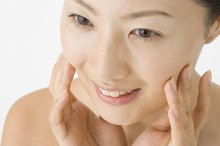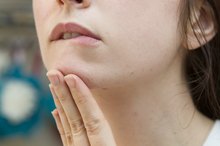Is There a Natural Way to Reduce Overactive Sebum Glands?
Oily and combination skin naturally produces excess sebum -- otherwise known as skin oils. For some this creates a sheen on the skin, while others experience blemishes from oil buildup. Skin needs to be balanced in order to minimize oil production without drying out. Some chemical products strip the skin and cause it to overcompensate by producing more sebum. Natural ingredients cleanse and nourish your skin without causing irritation. Take on a natural skin-care routine to reduce overactive sebum glands, and leave the blotting papers at home.
Cool Cleansing
Cleansing skin morning and night will help to prevent oil buildup and blackheads. Combine 1/2 cup of rolled oats, 1/4 cup of lemon juice, 1/4 cup of water and 1/2 tablespoon of honey. Wet your face with warm water to open your pores, and massage the mixture over your face using an upward circular motion for 30 seconds. Rinse with warm water and use a clean cotton cloth to wipe away any remaining cleanser.
- Cleansing skin morning and night will help to prevent oil buildup and blackheads.
- Wet your face with warm water to open your pores, and massage the mixture over your face using an upward circular motion for 30 seconds.
T-Zone Toning
Bio Oil for Wrinkles
Learn More
Toning is essential in balancing the skin. Drying out oily skin will only lead your skin to overcompensate with excess sebum production in the future. Witch hazel is a natural toner that is ideal for oily skin 1. It clears any remaining debris and residue from your pores, while restoring the natural pH balance. Skin is left feeling refreshed, but not tight and uncomfortable. Soak an exfoliating cotton pad in witch hazel after cleansing morning and night; smooth it over your skin, concentrating on the T-zone. The exfoliating cotton pad will gently remove dead skin as you tone and is less abrasive than a manual exfoliator.
- Toning is essential in balancing the skin.
- The exfoliating cotton pad will gently remove dead skin as you tone and is less abrasive than a manual exfoliator.
Helpful Hydration
Oily skin needs to be moisturized to prevent it from overproducing sebum. Use essential oils to stop sebum production, while treating any blemishes and calming redness. Sea Buckthorn Oil contains vitamins A, E and C and absorbs into the skin to fight internal and external aggressors. It strengthens the skin to promote balance and healing. Massage a dime-size amount of oil into your skin both morning and night. Use an upward circular motion to encourage sebum to drain and prevent under-the-skin blemishes. Apply the oil while your skin is still damp from cleansing and toning so that it can be thoroughly absorbed.
- Oily skin needs to be moisturized to prevent it from overproducing sebum.
- Apply the oil while your skin is still damp from cleansing and toning so that it can be thoroughly absorbed.
Mega Masks
How to Make Face Skin Produce Less Oil
Learn More
Create a mask with all-natural ingredients. Egg whites naturally tighten pores and can even help with hyperpigmentation and acne. Pour two egg whites into a bowl and use a whisk to mix them together. Smooth the mixture over your face after cleansing, and allow it to dry before rinsing with warm water. Use the mask twice a week to treat oily skin without drying it out.
- Create a mask with all-natural ingredients.
- Use the mask twice a week to treat oily skin without drying it out.
Related Articles
References
- Dr. Oz: Fixes for Oily Summer Skin
- Dr. Oz: Finding A Radiant Complexion Under Oily Skin
- Free People: Homemade Facial Cleansers
- Sea Buckthorn Insider: Dr. Oz Claims Sea Buckthorn Is a Miracle For Clearing Up Acne Prone Skin!
- Michelle Phan: Large Pores?
- Fischer H, Fumicz J, Rossiter H, Napirei M, Buchberger M, Tschachler E, Eckhart L. Holocrine Secretion of Sebum Is a Unique DNase2-Dependent Mode of Programmed Cell Death. J Invest Dermatol. 2017;137(3):587-594. doi:10.1016/j.jid.2016.10.017
- Schneider M, Paus R. Sebocytes, multifaceted epithelial cells: lipid production and holocrine secretion. Int J Biochem Cell Biol. 2010;42(2):181-5. doi:10.1016/j.biocel.2010.11.017
- Bagatin E, de Freitas T, Machado M, Ribeiro B, Nunes S, da Rocha M. Adult female acne: a guide to clinical practice. An Bras Dermatol. 2019;94(1): 62–75. doi:10.1590%2Fabd1806-4841.20198203
- Picardo M, Ottaviani M, Camera E, Mastrofrancesco A. Sebaceous gland lipids. Dermatoendocrinol. 2009;1(2):68-71. doi:10.4161%2Fderm.1.2.8472
- Lovászi M, Szegedi A, Zouboulis C, Törőcsik D. Sebaceous-immunobiology is orchestrated by sebum lipids. Dermatoendocrinol. 2017;9(1):e1375636. doi:10.1080/19381980.2017.1375636
- Zhou S, Li D, Zhou Y, Cao J. The skin function: a factor of anti-metabolic syndrome. Diabetol Metab Syndr. 2012;4(1):15. doi:10.1186/1758-5996-4-15
- Fox L, Csongradi C, Aucamp M, Du plessis J, Gerber M. Treatment Modalities for Acne. Molecules. 2016;21(8). doi:10.3390%2Fmolecules21081063
- Osterberg EC, Bernie AM, Ramasamy R. Risks of testosterone replacement therapy in men. Indian J Urol. 2014;30(1):2-7. doi:10.4103/0970-1591.124197
- Endly D, Miller R. Oily Skin: A review of Treatment Options. J Clin Aesthet Dermatol. 2017;10(8):49-55.
- Borda L, Wikramanayake T. Seborrheic Dermatitis and Dandruff: A Comprehensive Review. J Clin Investig Dermatol. 2015;3(2). doi:10.13188/2373-1044.1000019
- Szöllősi A, Oláh A, Bíró T, Tóth B. Recent advances in the endocrinology of the sebaceous gland. Dermatoendocrinol. 2017;9(1):e1361576. doi:10.1080%2F19381980.2017.1361576
- Strumia R. Eating disorders and the skin. Clin Dermatol. 2013;31(1):80-5. doi:10.1016/j.clindermatol.2011.11.011
- Purnamawati S, Indrastuti N, Danarti R, Saefudin T. The role of moisturizers in addressing various kinds of dermatitis: A review. Clin Med Res. 2017;15(3-4):75-87.
Writer Bio
Celeigh O'Neil has been writing professionally since 2008. She has a Bachelor of fine arts from the University of Ottawa, as well as degrees in fashion illustration/design, digital arts and certification in hair and makeup artistry. O'Neil was a frequent contributor to Toronto's "Dialog" newspaper and has worked as an instructional writer, creating lessons in fashion, art and English for students of all ages.









